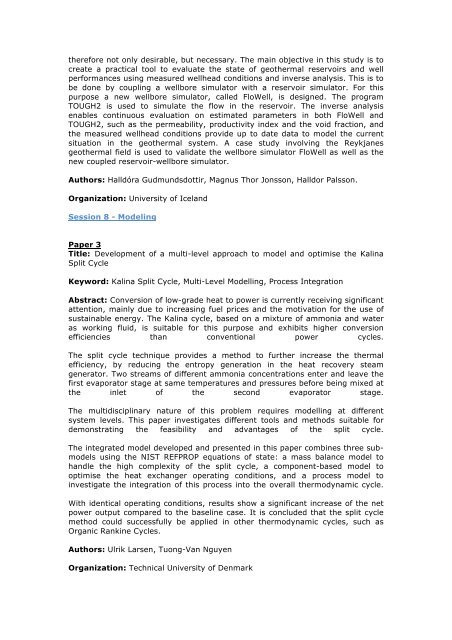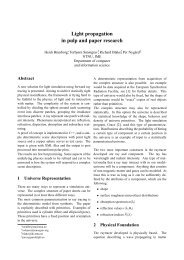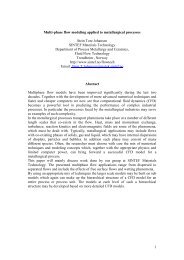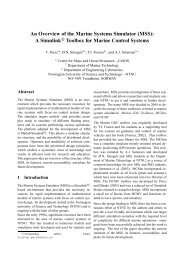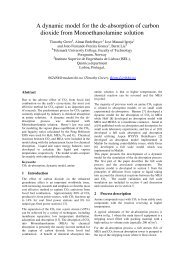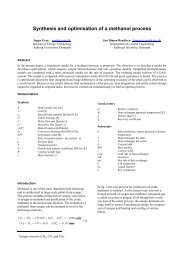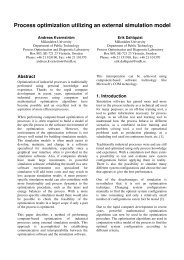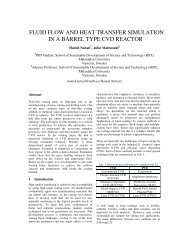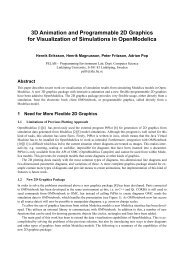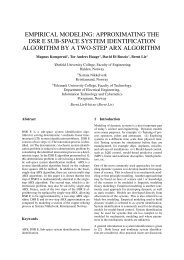detailed programme - SIMS - Scandinavian Simulation Society
detailed programme - SIMS - Scandinavian Simulation Society
detailed programme - SIMS - Scandinavian Simulation Society
Create successful ePaper yourself
Turn your PDF publications into a flip-book with our unique Google optimized e-Paper software.
therefore not only desirable, but necessary. The main objective in this study is to<br />
create a practical tool to evaluate the state of geothermal reservoirs and well<br />
performances using measured wellhead conditions and inverse analysis. This is to<br />
be done by coupling a wellbore simulator with a reservoir simulator. For this<br />
purpose a new wellbore simulator, called FloWell, is designed. The program<br />
TOUGH2 is used to simulate the flow in the reservoir. The inverse analysis<br />
enables continuous evaluation on estimated parameters in both FloWell and<br />
TOUGH2, such as the permeability, productivity index and the void fraction, and<br />
the measured wellhead conditions provide up to date data to model the current<br />
situation in the geothermal system. A case study involving the Reykjanes<br />
geothermal field is used to validate the wellbore simulator FloWell as well as the<br />
new coupled reservoir-wellbore simulator.<br />
Authors: Halldóra Gudmundsdottir, Magnus Thor Jonsson, Halldor Palsson.<br />
Organization: University of Iceland<br />
Session 8 - Modeling<br />
Paper 3<br />
Title: Development of a multi-level approach to model and optimise the Kalina<br />
Split Cycle<br />
Keyword: Kalina Split Cycle, Multi-Level Modelling, Process Integration<br />
Abstract: Conversion of low-grade heat to power is currently receiving significant<br />
attention, mainly due to increasing fuel prices and the motivation for the use of<br />
sustainable energy. The Kalina cycle, based on a mixture of ammonia and water<br />
as working fluid, is suitable for this purpose and exhibits higher conversion<br />
efficiencies than conventional power cycles.<br />
The split cycle technique provides a method to further increase the thermal<br />
efficiency, by reducing the entropy generation in the heat recovery steam<br />
generator. Two streams of different ammonia concentrations enter and leave the<br />
first evaporator stage at same temperatures and pressures before being mixed at<br />
the inlet of the second evaporator stage.<br />
The multidisciplinary nature of this problem requires modelling at different<br />
system levels. This paper investigates different tools and methods suitable for<br />
demonstrating the feasibility and advantages of the split cycle.<br />
The integrated model developed and presented in this paper combines three submodels<br />
using the NIST REFPROP equations of state: a mass balance model to<br />
handle the high complexity of the split cycle, a component-based model to<br />
optimise the heat exchanger operating conditions, and a process model to<br />
investigate the integration of this process into the overall thermodynamic cycle.<br />
With identical operating conditions, results show a significant increase of the net<br />
power output compared to the baseline case. It is concluded that the split cycle<br />
method could successfully be applied in other thermodynamic cycles, such as<br />
Organic Rankine Cycles.<br />
Authors: Ulrik Larsen, Tuong-Van Nguyen<br />
Organization: Technical University of Denmark


